
Reviewed by Timothy J. Barron

Reviewed by Timothy J. Barron
Arleigh Burke class (DDG) destroyers feature the U.S. Navy's latest warship technology, including AEGIS and stealthy features, with a multi-mission role including both offensive and defensive capabilities. The class is named after Arleigh Burke, one of the Navy's most famous destroyer commanders and former Chief of Naval Operations. The first ship of the class, USS Arleigh Burke DDG-51, was commissioned on July 4, 1991. Burkes are still actively being built, with DDG 112 slated to be the last ship of the class and scheduled to be commissioned in 2012.
There are three major variations of the class which are referred to as Flight I (DDG-51 to DDG-71), Flight II (DDG-72 to DDG-78), and Flight IIA (DDG-79 to end of class). The most noticeable change is the addition of a hangar on Flight IIA. It should be noted that there are also variations within each Flight, particularly Flight IIA. For example, beginning on DDG-89, the exhaust stacks are now enclosed, CIWS has been removed, etc. And then beginning on DDG-91, there is an added structure on the port side. This structure was originally intended for the Remote Mine-Hunting System (RMS), but this has now been cancelled.
In late 2004, Dragon released
a 1/700 scale kit of USS Mustin DDG-89. This kit is Dragon's third release
of an Arleigh Burke DDG class destroyer in 1/700 scale, preceded by a Flight
I (Arleigh Burke DDG-51) kit and a Flight IIA (Roosevelt DDG-80) kit. Other
manufacturers offering 1/700 scale Flight I and Flight II Burkes include
Pitroad/Skywave, and Fujimi. The kit represents or depicts USS Mustin DDG-89
as commissioned on July 26, 2003. The Mustin is named after the Mustin
family, which includes Captain Henry C. Mustin and Vice Admiral Lloyd Mustin.
The kit includes some noticeable changes that were made to Flight IIA ships
which differ, for example, with Dragon's earlier Flight IIA kit (Roosevelt
DDG-80).
Review of Kit Contents
The content of the box includes four individually wrapped sprues (labelled
A, B, C, and E), one decal sheet, and the instruction sheet.
Sprue A
Sprue
A Photo #1
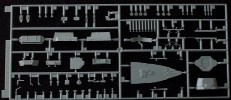 |
Sprue
A Photo #2
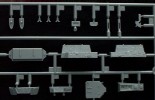 |
Sprue
A Photo #3
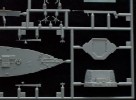 |
This
sprue contains a variety of parts that are common across the entire Burke
class. The super structures include molded doors, ladders, life preservers,
and other molded details. Also included on the sprue are two rigid hull
inflatable boats (RHIB) for the starboard side, and the Connected Replenishment
(CONREP) station devices. The molding of all parts on Sprue A are crisp,
with no ejector pin marks that would be visible on a completed model. All
parts appear to be fairly accurate when compared to US Navy photos - i.e.
all doors, venting, a detailing appear to be in the proper locations.
Sprue
B Sprue
B is a widely used sprue by Dragon, and included in many kits. Only a handful
of the parts are used with the Burke kits, namely the SH-60 Seahawk helicopter
and torpedoes. The SH-60B Seahawk is well molded, though the kit includes
no decals for it.
Sprue
C This
sprue contains the hull pieces. The ship could be modelled as waterline,
or full-hull. The molding of all parts on Sprue C are crisp, with no ejector
pin marks that would be visible on a completed model. The upper hull piece
is attached to the sprue in five places that are highly visible on a completed
model. These would have to be carefully cut and sanded smooth. The stern
deck contains many raised details, which can be seen in Photo
#2, including the landing stripes, though the kit includes a decal
for these same stripes. To ensure proper decal adhesion, some modelers
might elect to sand this deck smooth.
Sprue
E The hangar bay doors are molded closed, as shown in Photo
#2. At first glance, one may think that they could simply cut out the
doors on the part in order to model open hangar bays. Unfortunately, this
would not work as the part gets attached to other parts located directly
behind it. The hull has a raised structure (which can be seen Sprue C)
that the door piece attaches to. Cutting a significant amount of thick
plastic would be required to model open hangar bay doors.
The kit part for the redesigned 5" gun featured on Flight IIA Burkes
is shown in Photo #3. The kit's gun appears
to be molded in the correct shape, when compared to Photo
#5 (U.S. Navy Photo of DDG-89). Given the very sharp corners and edges
of the 5" gun shown in Photo #5, some modelers
may elect to sharpen the edges of the kit's gun with a little sanding.
Starting with DDG-89, the exhaust stacks are now recessed into the structure,
which is slightly taller as a result, which can be seen in Photo
#6 (U.S. Navy Photo of DDG-90). Note that the top of the exhaust structure
is completely flat. Photo #4 shows a close-up
of the kit part for the top of the exhaust structures, and note that the
part has raised exhaust details on one side. If you look back at Photo
#1, note that the reverse side of the part has recessed holes on the
other side. The diagram in the instructions seems to indicate that these
two parts are to be assembled with the raised details on top, which is
incorrect. The diagram is drawn wrong, and these parts are meant to have
the recessed holes on top, and the raised details facing downward. A dry
fit of these parts (while still on the sprues) confirms that the part could
be assembled wrong. The casual modeler will likely glue the exhaust stacks
upside down, based on the way the instructions show it.
When compared to U.S. Navy photos, all of the correct radomes appear
to be included for DDG-89 and DDG-90, as commissioned. The only exception
can be seen in Photo #6 (U.S. Navy Photo of
DDG-90). There is a radome on the front of the forward exhaust structure,
and the Mustin also had this radome when commissioned in 2003. The kit
includes the platform, but not the radome. This could easily be added from
scratch plastic or sprue, or even using the top part of a CIWS which are
unused parts in this build.
Decal
Sheet The
decal sheet, shown in Photo #1, contains hull
numbers, hull names, landing and warning stripes, and E award markings.
The decal sheet includes hull numbers and names for DDG-89 Mustin, DDG-90
Chafee, DDG-91 Pinckney, DDG-92 Momsen, and DDG-93 Chung-Hoon. The kit
can be used to accurately represent DDG-89 and DDG-90 out of the box, but
there is a issue with using this kit to model any Burkes starting with
DDG-91. The reason is that starting with DDG-91, a structure was added
to the starboard side, which can be seen in Photo
#2 (U.S. Navy Photo of DDG-91). Parts to represent this structure are
not included in the kit, so it would have to be scratchbuilt, though it
appears not all that complex to do. Given that DDG-91 was not commissioned
until mid-2004, and this kit was released only a short time later, Dragon
designers obviously did not have access to any photos at that time. The
structure was originally intended to house a Remote Mine-Hunting System
(RMS), but this system has been cancelled by the Navy and it is being removed
from any ships that already have it, such as DDG-91. According to the U.S.
Navy webmaster for the Pinckney's official website, the structure has a
stainless steel screen to cover the opening, which can be seen in Photo
#3 (U.S. Navy Photo of DDG-93). The U.S. Navy website contains a photo
of what the RMS looked like, housed in the structure on DDG-92. U.S. Navy
photos of DDG-94 and DDG-95 show that those ships were also built with
this structure. At the time of this review, I am unclear what will be done
with the structure on ships that currently have it, and what the design
of ships beyond DDG-95 will be (i.e. will future ships to be built revert
to the pre-DDG-91 design of not having the structure?).
The white stripes and red warning circles on the decal sheet all appear
to be accurate markings when compared to U.S. Navy photos. The red warning
circle might be a bit thick, and the stern numbers are a bit large. Also
included is a blue DESRON logo. The logo is accurate for the Mustin when
commissioned in 2003, as can be seen in this
photo. The Mustin has since changed DESRON squadrons (i.e. a 2005 photo
shows the Mustin with a red and white logo for the "Little Beavers" of
DESRON 23). Modeler's with a focus on accuracy will note that Burkes have
four vertical white stripes between the hangar bays on all Flight IIA ships,
as can be seen in Photo #4. (U.S. Navy Photo
of DDG-89). The decal sheet does not include these stripes.
Instruction
Sheet The
instruction sheet appears to be very clear and organized, which is typical
for Dragon. The only concern appears to be the error in diagram of the
exhaust structure, as described earlier. As is normally recommended, dated
photographs should be consulted for painting guidance. For example, the
painting instructions indicate to paint a particular radome white. A U.S.
Navy photo of the Mustin, as commissioned in 2003, shows this radome painted
gray.
Dragon's 1/700 scale USS Mustin DDG-89 kit has a retail price of $19.99,
and I picked it up at a local hobby store for $17.99, so it has an excellent
and attractive price point. The kit is sure to please both the casual modeler,
as well as the most discriminating of modelers, based on Dragon's product
quality and the accuracy of the kit. The kit will enable someone to easily
build a highly accurate USS Mustin DDG-89, and USS Chafee DDG-90, as commissioned,
straight out of the box. The discriminating modeler will only have to add
a small radome, the white stripes between the hangar bay doors, and potentially
small other details not covered in this review. With a very minor amount
of beginner-level scratchbuilding, the new starboard side structure (that
was to house the RMS) could easily be added, so this kit could easily serve
as the basis for any post DDG-91 Burke. The addition of optional photoetch
details would exploit the fine detailing that the kit already has. Dragon
should be commended for aggressively and quickly releasing another Burke
kit, which includes some of the latest features.
The Discovery Channel recently aired
a program called "Destroyer: Forged in Steel." The hour long program shows
the building of the USS Chafee DDG-90, and is both interesting viewing
and a great resource for modeling this exact kit.
The following are links to some websites that contain information on
Burke class destroyers:
U.S.
Navy Fact File - Destroyers - The site contains information on the
Burkes and links to each ship's official website.
The U.S. Navy NewsStand website contains numerous high-resolution photos
of current ships, and is a top resource. Below are links to photos as of
April 28, 2005. Use the search feature at a later date, as you may find
more photos..
USS Mustin DDG-89
USS
Chaffee DDG-90
USS
Pinckney DDG-91
USS
Momsen DDG-92
USS Chung-Hoon DDG-93
Sprue
B Photo #1
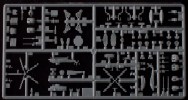
Sprue
C Photo #1
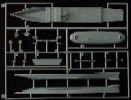
Sprue
C Photo #2
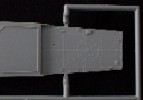
Sprue
E Photo #1
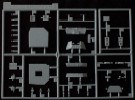
Sprue
E Photo #2
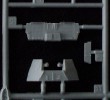
Sprue
E Photo #3
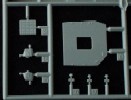
Sprue
E Photo #4

Sprue
E Photo #5
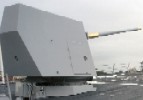
Sprue
E Photo #6
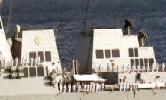
Sprue
E contains parts relevant to Flight IIA Burkes, such as parts for the hangar
bay, the redesigned 5" gun, and the recessed exhaust stacks that begin
on DDG-89.
Decal
Sheet Photo #1
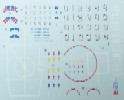
Decal
Sheet Photo #2
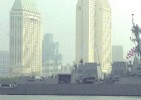
Decal
Sheet Photo #3
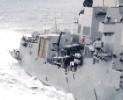
Decal
Sheet Photo #4
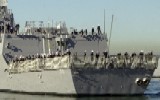
Instruction
Sheet Photo #1
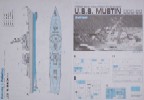
Instruction
Sheet Photo #2
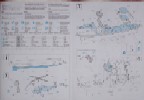
Instruction
Sheet Photo #3
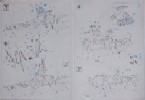
Instruction
Sheet Photo #4
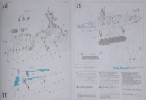
Conclusion
References
NavSource - Contains numerous
photos of many Burkes.
GlobalSecurity.org
- Contains detailed information on Burkes, including some photos.
http://www.navy.mil/view_single.asp?id=7969
http://www.navy.mil/view_single.asp?id=7950
http://www.navy.mil/view_single.asp?id=7951
http://www.navy.mil/view_single.asp?id=8729
http://www.navy.mil/view_single.asp?id=8730
http://www.navy.mil/view_single.asp?id=8768
http://www.navy.mil/view_single.asp?id=8769
http://www.navy.mil/view_single.asp?id=8809
http://www.navy.mil/view_single.asp?id=8810
http://www.navy.mil/view_single.asp?id=21442
http://www.navy.mil/view_single.asp?id=21446
http://www.navy.mil/view_single.asp?id=21447
http://www.navy.mil/view_single.asp?id=23630
http://www.navy.mil/view_single.asp?id=23666
http://www.navy.mil/view_single.asp?id=23667
http://www.navy.mil/view_single.asp?id=23756
http://www.navy.mil/view_single.asp?id=23757
http://www.navy.mil/view_single.asp?id=10146
http://www.navy.mil/view_single.asp?id=11139
http://www.navy.mil/view_single.asp?id=11144
http://www.navy.mil/view_single.asp?id=11145
http://www.navy.mil/view_single.asp?id=11146
http://www.navy.mil/view_single.asp?id=11159
http://www.navy.mil/view_single.asp?id=11160
http://www.navy.mil/view_single.asp?id=11161
http://www.navy.mil/view_single.asp?id=11165
http://www.navy.mil/view_single.asp?id=11173
http://www.navy.mil/view_single.asp?id=11174
http://www.navy.mil/view_single.asp?id=18551
http://www.navy.mil/view_single.asp?id=18552
http://www.navy.mil/view_single.asp?id=18553
http://www.navy.mil/view_single.asp?id=22742
http://www.navy.mil/view_single.asp?id=22757
http://www.navy.mil/view_single.asp?id=13898
http://www.navy.mil/view_single.asp?id=3736
http://www.navy.mil/view_single.asp?id=17557
http://www.navy.mil/view_single.asp?id=19748
http://www.navy.mil/view_single.asp?id=17183
http://www.navy.mil/view_single.asp?id=17282
http://www.navy.mil/view_single.asp?id=18152
http://www.navy.mil/view_single.asp?id=13927
http://www.navy.mil/view_single.asp?id=16534
http://www.navy.mil/view_single.asp?id=17599
http://www.navy.mil/view_single.asp?id=17601
http://www.navy.mil/view_single.asp?id=17602
http://www.navy.mil/view_single.asp?id=17604
http://www.navy.mil/view_single.asp?id=17603
http://www.navy.mil/view_single.asp?id=17605
http://www.navy.mil/view_single.asp?id=17606
http://www.navy.mil/view_single.asp?id=17633
http://www.navy.mil/view_single.asp?id=17693
http://www.navy.mil/view_single.asp?id=17724
http://www.navy.mil/view_single.asp?id=17725
http://www.navy.mil/view_single.asp?id=17726
http://www.navy.mil/view_single.asp?id=17730
http://www.navy.mil/view_single.asp?id=17731
http://www.navy.mil/view_single.asp?id=17732
http://www.navy.mil/view_single.asp?id=17734

© ModelWarships.com